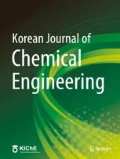Abstract
CaO carbonation with CO2 is potentially a very important reaction for CO2 removal from exhaust gas produced in power plants and other metallurgical plants and for hydrogen production by promoting water gas shift reaction in fossil fuel gasification. A mathematical model based on the grain model was applied for modeling of this reaction. Diffusion of gaseous phase through the product layer and structural change of the grains were considered in the model. The modeling results show that ignoring the reaction kinetics controlling regime in the early stage of the reaction and replacing it with a regime considering both the reaction kinetics and diffusion can generate good simulation results. The frequency factor of the reaction rate equation and the diffusivity of CO2 through the CaCO3 layer were justified to get the best fit at different temperature range from 400 to 750 °C with respect to experimental data in the literature. The mathematical model switches to a pure diffusion controlling regime at final stage of reaction.
Similar content being viewed by others

References
S. Eloneva, Mineral carbonation process modeling and carbonate product stability, Helsinki University of Technology (2004).
T. Koljonen, H. Siikavirta and R. Zevenhoven, CO2 Capture and Storage and Utilization In Finalnd, Valtion teknillinen tutkimuskeskus, Project Report PRO4/T7504/02, 95 (2002).
S. K. Bhatia and D. D. Perlmutter, AIChE J., 29, 1, 79 (1983).
A. J. Dedman and A. J. Owen, Trans. Soc., 58, 2027 (1982).
W. G. Oakeson and I. B. Culter, J. Am. Cream. Soc., 62, 11&556 (1979).
H. Gupta and L. S. Fan, Ind. Eng. Chem., 41, 4035 (2002).
D. K. Lee, I. H. Baek and W. L. Yoon, Chem. Eng. Sci., 59, 931 (2004).
D. K. Lee, Chem. Eng. J., 100, 71 (2004).
V. Nikulshina, M. E. Gálvez and A. Steinfeld, Chem. Eng. J., 129, 75 (2007).
B.R. Stanmore and P. Gilot, Fuel Process. Technol., 86, 1707 (2005).
B. Khoshandam, R. V. Kumar and E. Jamshidi, Trans. Inst. Min. Metall. C, 114, C10 (2005).
J. Szekely, J.W. Evans and H.Y. Sohn, Gas-solid reactions, Academic Press, New York (1976).
O. Levenspiel, Chemical reaction engineering, Wiley, New York (1965).
N. Wakao and J. M. Smith, Chem. Eng. Sci., 17, 825 (1962).
C. N. Satterfield, Mass transfer in heterogeneous catalysis, MIT Press, Cambridge, MA (1970).
E.A. Mason, A. P. Malinauskas and R. B. Evans, J. Chem. Phys., 46 (1967).
Author information
Authors and Affiliations
Corresponding author
Rights and permissions
About this article
Cite this article
Khoshandam, B., Kumar, R.V. & Allahgholi, L. Mathematical modeling of CO2 removal using carbonation with CaO: The grain model. Korean J. Chem. Eng. 27, 766–776 (2010). https://doi.org/10.1007/s11814-010-0119-5
Received:
Accepted:
Published:
Issue Date:
DOI: https://doi.org/10.1007/s11814-010-0119-5



